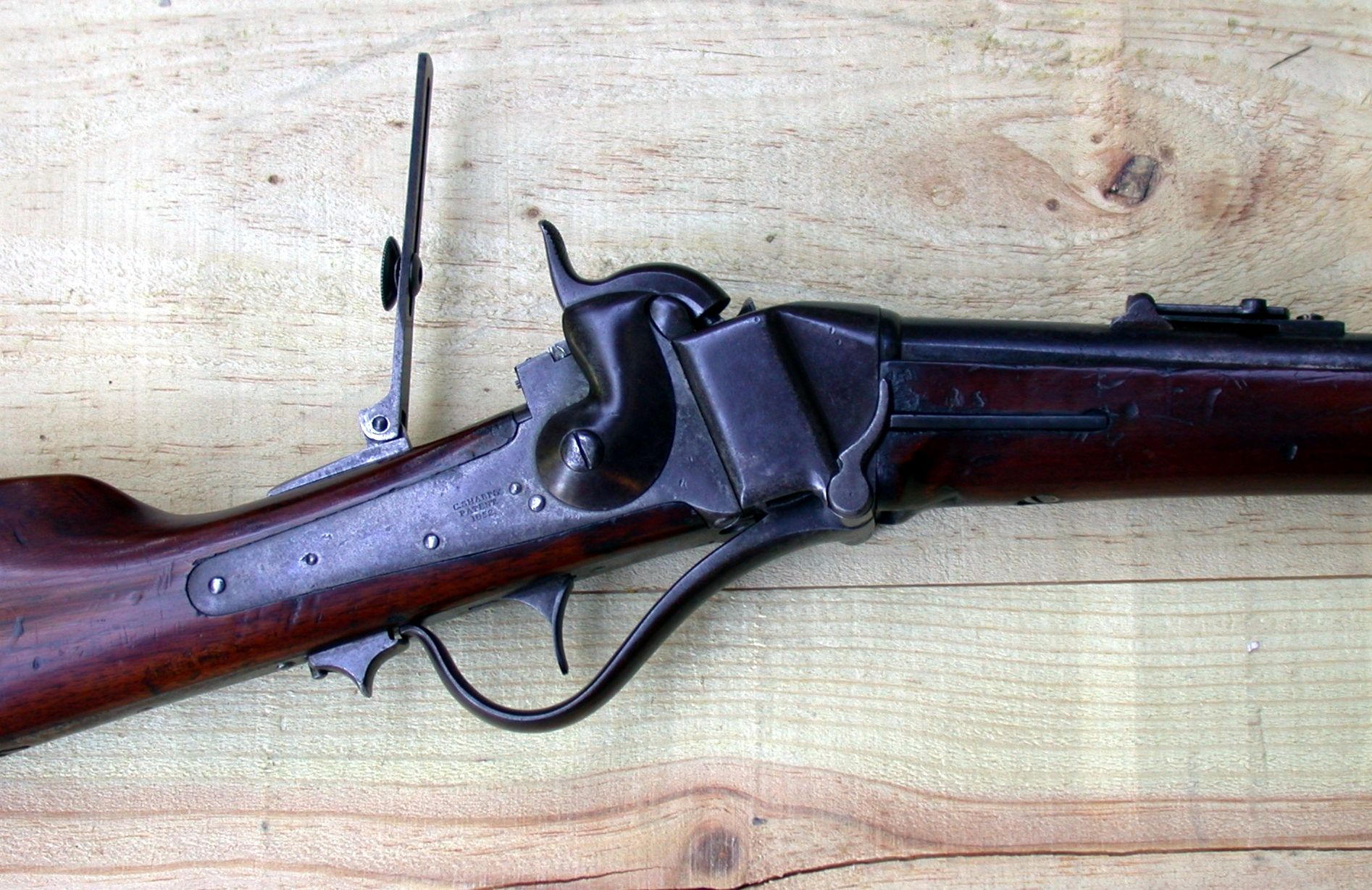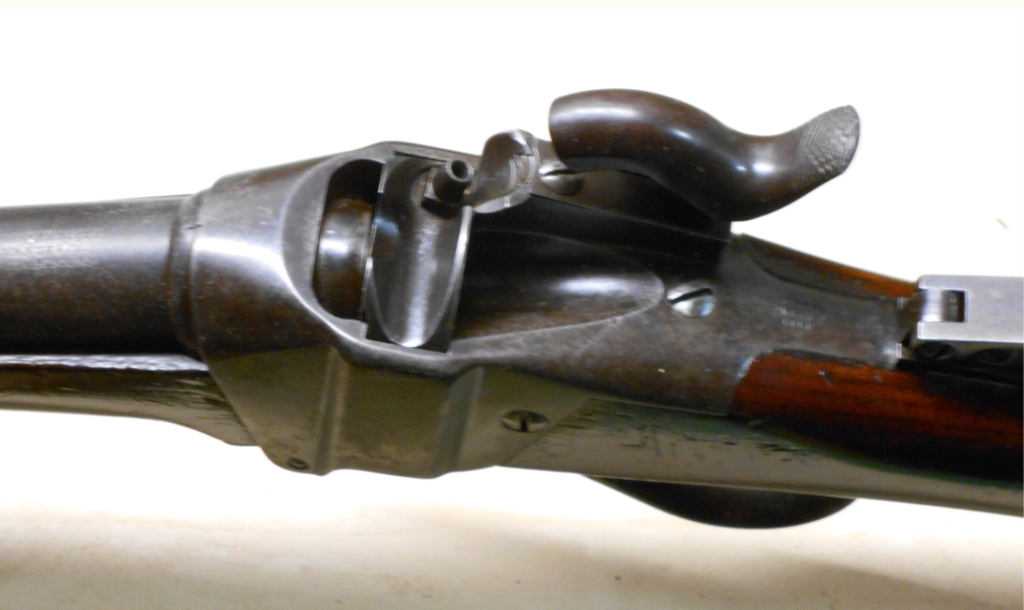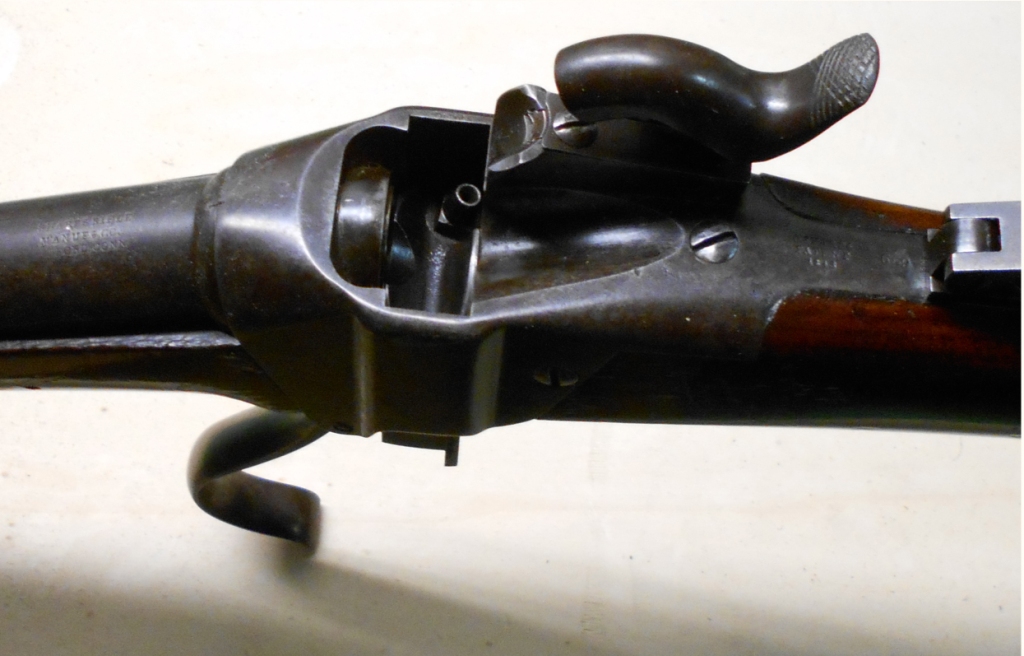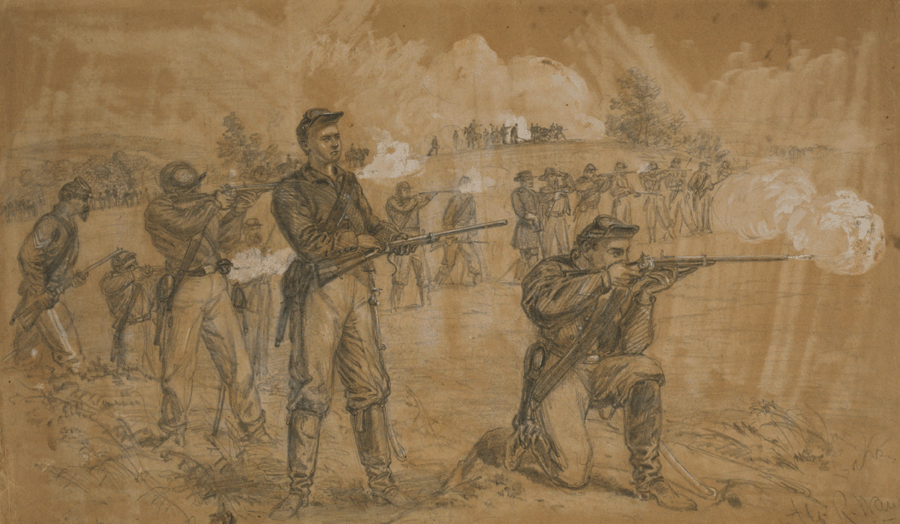Sharps Rifle on:
[Wikipedia]
[Google]
[Amazon]




 Sharps rifles are a series of large-bore,
Sharps rifles are a series of large-bore,
 The carbine version was very popular with the cavalry of both the Union and Confederate armies and was issued in much larger numbers than other carbines of the war and was top in production in front of the Spencer or Burnside carbine. The falling-block action lent itself to conversion to the new metallic cartridges developed in the late 1860s, and many of these converted carbines in .50-70 Government were used during the
The carbine version was very popular with the cavalry of both the Union and Confederate armies and was issued in much larger numbers than other carbines of the war and was top in production in front of the Spencer or Burnside carbine. The falling-block action lent itself to conversion to the new metallic cartridges developed in the late 1860s, and many of these converted carbines in .50-70 Government were used during the  The British purchased 1,000 Model 1852 carbines in 1855 which were later used in the
The British purchased 1,000 Model 1852 carbines in 1855 which were later used in the
Sharps Model 1874 - Background history
Sharps Model 1874 - Shooting and reloading
* * * {{DEFAULTSORT:Sharps Rifle American Civil War rifles Early rifles Rifles of the United States Guns of the American West Falling-block rifles Indian Rebellion of 1857 Hunting rifles



single-shot
In firearm designs, the term single-shot refers to guns that can hold only a single round of ammunition inside and thus must be reloaded manually after every shot. Compared to multi-shot repeating firearms ("repeaters"), single-shot designs have ...
, falling-block, breech-loading
A breechloader is a firearm in which the user loads the ammunition from the breech end of the barrel (i.e., from the rearward, open end of the gun's barrel), as opposed to a muzzleloader, in which the user loads the ammunition from the ( muzzle ...
rifles
A rifle is a long-barreled firearm designed for accurate shooting and higher stopping power, with a barrel that has a helical or spiralling pattern of grooves ( rifling) cut into the bore wall. In keeping with their focus on accuracy, rifle ...
, beginning with a design by Christian Sharps in 1848 and ceasing production in 1881. They were renowned for long-range accuracy. By 1874, the rifle was available in a variety of calibers, and it was one of the few designs to be successfully adapted to metallic cartridge use. The Sharps rifles became icons of the American Old West
The American frontier, also known as the Old West, and popularly known as the Wild West, encompasses the geography, history, folklore, and culture associated with the forward wave of American expansion in mainland North America that bega ...
with their appearances in many Western-genre films and books. Perhaps as a result, several rifle companies offer reproductions of the Sharps rifle.
History
Sharps' initial rifle was patented September 12, 1848, and manufactured by A. S. Nippes at Mill Creek inPhiladelphia
Philadelphia ( ), colloquially referred to as Philly, is the List of municipalities in Pennsylvania, most populous city in the U.S. state of Pennsylvania and the List of United States cities by population, sixth-most populous city in the Unit ...
, Pennsylvania, in 1850.
The second model used the Maynard tape primer, and surviving examples are marked ''Edward Maynard - Patentee 1845''. In 1851, the second model was brought to the Robbins & Lawrence Company (R&L) of Windsor, Vermont, where the Model 1851 was developed for mass production. Rollin White of R&L invented the knife-edge breech block and self-cocking device for the "box-lock" Model 1851. This is referred to as the "first contract", which was for 10,000 Model 1851 carbines, of which approximately 1,650 were produced by R&L in Windsor.
In 1851, the "second contract" was made, for 15,000 rifles, and the Sharps Rifle Manufacturing Company was organized as a holding company with $1,000 in capital and with John C. Palmer as president, Christian Sharps as engineer, and Richard S. Lawrence as master armorer and superintendent of manufacturing. Sharps was to be paid a royalty of $1 per firearm, and the factory was built on R&L's property in Hartford, Connecticut
Hartford is the List of capitals in the United States, capital city of the U.S. state of Connecticut. The city, located in Hartford County, Connecticut, Hartford County, had a population of 121,054 as of the 2020 United States census, 2020 ce ...
.
The Model 1851 was replaced in production by the Model 1853. Christian Sharps left the company in 1855 to form his own manufacturing company called "C. Sharps & Company" in Philadelphia; Lawrence continued as the chief armorer until 1872 and developed the various Sharps models and their improvements that made the rifle famous. In 1874, the company was reorganized and renamed the "Sharps Rifle Company," and it remained in Hartford until 1876, whereupon it relocated to Bridgeport, Connecticut
Bridgeport is the List of municipalities in Connecticut, most populous city in the U.S. state of Connecticut and the List of cities in New England by population, fifth-most populous city in New England, with a population of 148,654 in 2020. Loc ...
.
The Sharps rifle played a prominent role in the Bleeding Kansas
Bleeding Kansas, Bloody Kansas, or the Border War, was a series of violent civil confrontations in Kansas Territory, and to a lesser extent in western Missouri, between 1854 and 1859. It emerged from a political and ideological debate over the ...
conflict during the 1850s, particularly in the hands of anti-slavery forces. The Sharps rifles supplied to anti-slavery factions earned the name " Beecher's Bibles", after the famed abolitionist Henry Ward Beecher.
The Model 1874 Sharps (this model had been in production since 1871) was a particularly popular rifle that led to the introduction of several derivatives in quick succession. It handled a large number of .40 to .50 caliber cartridges in a variety of loadings and barrel lengths. Hugo Borchardt designed the Sharps-Borchardt Model 1878, the last rifle made by the Sharps Rifle Co. before its closing in 1881.
Reproductions of the paper cartridge
A paper cartridge is one of various types of small arms ammunition used before the advent of the cartridge (firearms), metallic cartridge. These cartridges consisted of a paper cylinder or cone containing the bullet, gunpowder, and in some case ...
Sharps Model 1859 and Model 1863 rifle and carbine, the metallic-cartridge Model 1874 Sharps rifle, and Sharps-Borchardt Model 1878 have been manufactured for use in Civil War re-enacting, hunting
Hunting is the Human activity, human practice of seeking, pursuing, capturing, and killing wildlife or feral animals. The most common reasons for humans to hunt are to obtain the animal's body for meat and useful animal products (fur/hide (sk ...
, and target shooting.
Military use
Rifle
The military Sharps rifle was produced by the Sharps Rifle Manufacturing Company and is a falling-block rifle used during and after theAmerican Civil War
The American Civil War (April 12, 1861May 26, 1865; also known by Names of the American Civil War, other names) was a civil war in the United States between the Union (American Civil War), Union ("the North") and the Confederate States of A ...
in multiple variations. Along with being able to use a standard percussion cap
The percussion cap, percussion primer, or caplock, introduced in the early 1820s, is a type of single-use percussion ignition device for muzzle loader firearm locks enabling them to fire reliably in any weather condition. Its invention gave ...
, the Sharps has an unusual pellet primer feed. This is a device which holds a stack of pelleted primers and flips one over the nipple
The nipple is a raised region of tissue on the surface of the breast from which, in lactating females, breast milk, milk from the mammary gland leaves the body through the lactiferous ducts to Breastfeeding, nurse an infant. The milk can flow th ...
each time the trigger is pulled and the hammer falls—making it much easier to fire a Sharps from horseback than a gun employing individually loaded percussion caps.
It was used in the Civil War by multiple Union units, most famously by the U.S. Army marksmen known popularly as " Berdan's Sharpshooters" in honor of their leader, Hiram Berdan. The Sharps rifle made a superior sniper
A sniper is a military or paramilitary marksman who engages targets from positions of concealment or at distances exceeding the target's detection capabilities. Snipers generally have specialized training and are equipped with telescopic si ...
weapon of greater accuracy than the more commonly issued muzzle-loading
A muzzleloader is any firearm in which the user loads the projectile and the propellant charge into the muzzle end of the gun (i.e., from the forward, open end of the gun's barrel). This is distinct from the modern designs of breech-loading fire ...
rifled musket
A rifled musket, rifle musket, or rifle-musket is a type of firearm made in the mid-19th century. Originally the term referred only to muskets that had been produced as a smoothbore weapon and later had their Gun barrel, barrels replaced with Ri ...
s. This was attributed to the higher rate of fire of the breech loading
Breech may refer to:
* Breech (firearms), the opening at the rear of a gun barrel where the cartridge is inserted in a breech-loading weapon
* breech, the lower part of a pulley block
* breech, the penetration of a boiler where exhaust gases leave ...
mechanism and superior quality of manufacture, as well as the ease with which it could be reloaded from a kneeling or prone position.
At this time however, many officers were distrustful of breech-loading weapons on the grounds that they would encourage men to waste ammunition. In addition, the Sharps rifle was expensive to manufacture (three times the cost of a muzzle-loading Springfield rifle) and so only 11,000 of the Model 1859s were produced. Most were unissued or given to sharpshooters, but the 13th Pennsylvania Reserves (which still carried the old-fashioned designation of a "rifle regiment") carried them until being mustered out in 1864.
Carbine
 The carbine version was very popular with the cavalry of both the Union and Confederate armies and was issued in much larger numbers than other carbines of the war and was top in production in front of the Spencer or Burnside carbine. The falling-block action lent itself to conversion to the new metallic cartridges developed in the late 1860s, and many of these converted carbines in .50-70 Government were used during the
The carbine version was very popular with the cavalry of both the Union and Confederate armies and was issued in much larger numbers than other carbines of the war and was top in production in front of the Spencer or Burnside carbine. The falling-block action lent itself to conversion to the new metallic cartridges developed in the late 1860s, and many of these converted carbines in .50-70 Government were used during the Indian Wars
The American Indian Wars, also known as the American Frontier Wars, and the Indian Wars, was a conflict initially fought by European colonial empires, the United States, and briefly the Confederate States of America and Republic of Texas agains ...
in the decades immediately following the Civil War.
Some Civil War–issue carbines have an unusual feature: a hand-cranked grinder in the stock. Although long thought to be a coffee mill, experimentation with some of the few survivors suggests the grinder is ill-suited for coffee. The modern consensus is that its true purpose was for grinding corn or wheat or, more appropriately, for grinding charcoal needed in the production of black powder
Gunpowder, also commonly known as black powder to distinguish it from modern smokeless powder, is the earliest known chemical explosive. It consists of a mixture of sulfur, charcoal (which is mostly carbon), and potassium nitrate, potassium ni ...
.
Unlike the Sharps rifle, the carbine was very popular, and almost 90,000 were produced. By 1863, it was the most common weapon carried by Union cavalry regiments, although in 1864 many were replaced by seven-shot Spencer carbines. Some Sharps clones were produced by the Confederates in Richmond. Quality was generally poorer, and they normally used brass fittings instead of iron.
 The British purchased 1,000 Model 1852 carbines in 1855 which were later used in the
The British purchased 1,000 Model 1852 carbines in 1855 which were later used in the Indian Rebellion of 1857
The Indian Rebellion of 1857 was a major uprising in India in 1857–58 against Company rule in India, the rule of the East India Company, British East India Company, which functioned as a sovereign power on behalf of the The Crown, British ...
.
Sporting rifles
Sharps made sporting versions from the late 1840s until the early 1880s. After the American Civil War, converted army surplus rifles were made into custom firearms, and the Sharps factory produced Models 1869 and 1874 in large numbers for commercial buffalo hunters and frontiersmen. These large-bore rifles were manufactured with some of the most powerful black powder cartridges ever made. Sharps also fabricated special long-range target versions for the popular Creedmoor style of target shooting. Many modern black powder cartridge silhouette shooters use original and replica Sharps rifles to target metallic silhouettes cut in the shapes of animals at ranges up to . Shiloh Rifle Manufacturing Company and C Sharps Arms ofBig Timber, Montana
Big Timber is a city in, and the county seat of, Sweet Grass County, Montana, Sweet Grass County, Montana, United States. The population was 1,650 at the 2020 United States census, 2020 census.
Big Timber takes its name from Big Timber Creek, w ...
, have been manufacturing reproductions of the Sharps rifle since 1983, respectively.
Rifle cartridges
Between 1871 and 1880, Sharps rifles were chambered in 15 different cartridges that had bore diameters of .40, .44, .45, and .50 inches with either a bottleneck or straight-walled case. These cartridges included the .40-1 Bottleneck ( .40-50 Sharps Bottleneck), .40-1 Straight ( .40-50 Sharps Straight), .40-2 Bottleneck (.40-70 Sharps Bottleneck), .40-2 Straight (.40-70 Sharps Bottleneck), .40-2 Bottleneck (.40-90 Sharps Bottleneck), .44-1 (.44-60 Sharps), .44-2 (.44-77 Sharps or Remington), .44-2 (.44-90 Sharps), .45-2 ( .45-70 Government), .45-2 (.45-90 Sharps or Winchester), .45-2 (.45-100 Sharps), .45-2 (.45-110 Sharps), .50-1 ( .50-70 Government), .50-2.00 (No Modern Equivalent), and .50-2 ( .50-90 Sharps).Cultural significance
In 1990, theWestern
Western may refer to:
Places
*Western, Nebraska, a village in the US
*Western, New York, a town in the US
*Western Creek, Tasmania, a locality in Australia
*Western Junction, Tasmania, a locality in Australia
*Western world, countries that id ...
film '' Quigley Down Under'', Tom Selleck's title character uses a Sharps rifle chambered in the .45-110, also known as the 45-2" Sharps. Theater Crafts Industry went so far as to say, "In ''Quigley Down Under'', which we did in 1990, the Sharps rifle practically co-stars with Tom Selleck." This statement was echoed by gunwriters including John Taffin in ''Guns
A gun is a device that propels a projectile using pressure or explosive force. The projectiles are typically solid, but can also be pressurized liquid (e.g. in water guns or cannons), or gas (e.g. light-gas gun). Solid projectiles may be ...
'' and Lionel Atwill in '' Field & Stream'', crediting the film with an impact to rival that of '' Dirty Harry'' on the Smith & Wesson Model 29 chambered in .44 Remington Magnum. Burt Lancaster's character Valdez in the movie '' Valdez Is Coming'' (1971) uses a Sharps rifle with deadly results at almost . Also, in the western '' Billy Two Hats'' (1974), David Huddleston's character Copeland wounds Gregory Peck's character, Archie Deans, at a far distance.
Firearms manufacturers such as Davide Pedersoli and Shiloh Rifle Manufacturing Company have credited these movies with an increase in demand for those rifles. As a result of the popularity of the film, a Sharps match is held annually in Forsyth, Montana, known as the "Matthew Quigley Buffalo Rifle Match". Originally, a target was placed at for each shooter, reminiscent of a scene from the movie. The match is billed as the "biggest rifle event shooting in Eastern Montana since the Custer Massacre" and has since developed into a two-day competition with eight shots for score on six steel silhouette targets at ranges from .
See also
* .50-90 Sharps * Billy Dixon, Medal of Honor recipient at theSecond Battle of Adobe Walls
The Second Battle of Adobe Walls was fought on June 27, 1874, between Comanche forces and a group of 28 Texan bison hunters defending the settlement of Adobe Walls, Texas, Adobe Walls, in what is now Hutchinson County, Texas. "Adobe Walls was ...
* Rifles in the American Civil WarNotes
References
* Coates, Earl J., and Thomas S. Dean. ''An Introduction to Civil War Small Arms''. Gettysburg, Penn.: Thomas Publications, 1990. . * Marcot, Roy - Marron, Edward - Paxton, Ron. "Sharps Firearms: The Percussion Era 1848 - 1865", April 2019 * Sellers, Frank M. ''Sharps Firearms''. North Hollywood, Calif: Beinfeld Pub, 1978. . * Smith, Winston O. ''The Sharps Rifle, Its History, Development and Operation''. New York: William Morrow and Company, 1943. *External links
Sharps Model 1874 - Background history
Sharps Model 1874 - Shooting and reloading
* * * {{DEFAULTSORT:Sharps Rifle American Civil War rifles Early rifles Rifles of the United States Guns of the American West Falling-block rifles Indian Rebellion of 1857 Hunting rifles